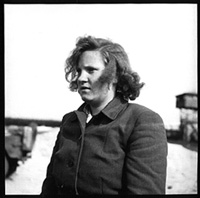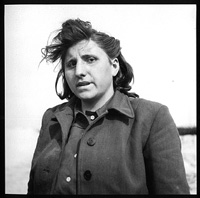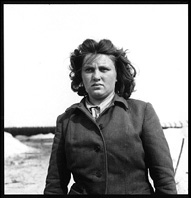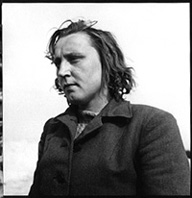7 |
 |
In April, 1945, British photographer and writer George Rodger, who later would be one of Magnum agency's founders with Cartier-Bresson, Chim and Capa, heard Winston Churchill addressing the British Army. Churchill said: "Gentlemen, you are now entering the dire sink of iniquity."
Rodger thought that the old boy was overdoing his metaphors a bit. His experience and that of other press photographers such as Margaret Bourke-White, John Florea, Lee Miller, Dave Scherman and William Vandivert are part of the larger material studied by Barbie Zelizer in her extraordinary book Remembering to Forget/Holocaust memory through the camera's eye. Zelizer's thesis is that the Holocaust is a mental frontier: before, news reporters mostly told their stories in words; after, photography gained full prominence in story-telling. Zelizer also considers how images of the camp have affected contemporary photojournalism: pictures of Nazi atrocities are echoed today in the photographs taken in Bosnia, Rwanda and Cambodia; that echo can have the negative effect of dulling our response to them. Each of the photographers who decided to make their Holocaust pictures part of public memory had to deal with the enormous impact of what they saw. Each did it differently. In Rodger's case, "When I discovered that I could look at the horror of Belsen... and think only of a nice photographic composition, I knew something had happened to me and I had to stop," said Rodger. He decided never again to be a war photographer, and for most of the rest of his life sought alternative ways of life close to nature, becoming a premier photographer of African tribal life. His 1955 book Village of the Nubas, originally published by Delpire in his Huit collection, is reissued as a facsimile by Phaidon, London, this fall. It features extraordinary pictures of the Kordofan Nuba warriors in their bracelet fights or carrying out their everyday activities in their villages with pointed domes made of mud. One muscular, ash-rubbed warrior is wearing a pair of heron wings strapped to his back. Phaidon has also just reissued a Rodger monograph with text by Bruce Bernard: Humanity and Inhumanity: The photographic journey of George Rodger (foreword by Henri Cartier-Bresson). It traces Rodger's extraordinary life from the London Blitz to a circumcision in a Masai tribe that had never before allowed a white man in their midst. |
||
| 1945, Belsen. Camp superintendent, Charlotte Pliquet, 20, of Konigsberg. | ||||
 |
||||
| 1945, Belsen. Camp superintendent, Magdalene Kessal, 25, was a domestic servant from Breslau. | ||||
 |
||||
| 1945, Belsen. Camp superintendent, Heldegard Kanbach, 23, was a textile worker from Hirschberg, Silesia. | ||||
 |
||||
|
1945,
Belsen. Camp superintendent, Frieda Walter, 23, was a textile worker
from Beutnen, Lower Silesia. |
||||
| ...has influenced an entire generation... | ||||
| INDEX | ||||